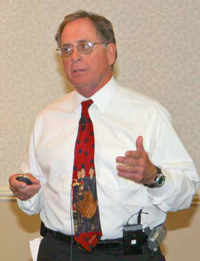An economics researcher found that infants’ proximity to smoke pollution while in utero affects birth weight.
Above: Whitetail Fire in South Dakota
(Originally published at 6:17 p.m. MST January 22, 2018)
When researchers seek to determine a single or primary cause for a human health problem, they know they’re battling uphill. Our environments are complex, multifaceted, and permeated by a seemingly infinite number of factors that could shape us. Rare is the circumstance that is so ideal, at least from a researcher’s perspective, that one can sift through the noise and emerge with a definitive root of an issue.
That is, of course, unless nature is on your side — as was the case for UNLV economics professor Shawn McCoy and his University of Pittsburgh economics colleague Xiaoxi Zhao.
It’s hard to imagine anything positive coming out of wildfires. They’ve become six times more likely to occur and four times as large since the 1980s, McCoy said, due to climate and population changes. And yet for his research, which demonstrates that proximity to smoke pollution causes lower infant birthweight, wildfires proved to be a sort of equalizer.
“Wildfires are a meaningful topic to research in and of themselves, but they also help solve this causality problem that is difficult in our studies of pollution,” McCoy said. “Two features make fire pollution different from that of, say, an industrial plant: the random timing of fires and their random location, in that wind patterns on any given day drive the direction and concentration of smoke. This sets up a quasi-experimental research design wherein a fire happens randomly and by chance and randomly and naturally assigns treatment and control groups, because only a certain segment of the population will be exposed to the smoke.”
Several studies have established correlations between pollution sources and negative public health outcomes, McCoy said. However, prior research has faced difficulties demonstrating a direct causal relationship. One reason for this, according to McCoy, is the number of factors that could be involved in past research scenarios.
“Suppose we build an industrial plant,” McCoy said. “Once that plant is built, we need to think about the economics of that problem, which is that people don’t like to live next to plants. Holding everything else constant, home prices will drop in the surrounding area because of that, which could induce geographical sorting, wherein households with lower income might migrate into the areas surrounding the plant and households with higher incomes may leave. When that happens, it becomes harder to determine if changes in health outcomes occurred because of plant pollution, geographical sorting dynamics, or even something else.”
The random timing and location of wildfires mitigate these dynamics, making it ideal for McCoy and Zhao’s research. Wildfire smoke is similar to other sources of ambient air pollution; its particulate matter can be so small that it passes through the heart and lungs, disrupts fetal nutrition, and slows fetal growth. Within this framework, birthweight becomes a useful metric to track because of its link to short-term outcomes, such as one-year mortality rates, as well as long-term outcomes such as educational attainment and earnings, McCoy said.
McCoy and Zhao leveraged geographic information systems (mapping software) to identify ignition sources and smoke paths and plotted the home addresses of infants born during a time that would place them in the smoke’s path while in utero. They then compared the birthweight of those infants to a control group outside of the smoke’s path.
The researchers’ results indicate that wildfire smoke leads to a 4 to 6 percent reduction in birthweight, and these effects are most pronounced among mothers exposed to smoke during the second or the third trimesters of pregnancy. They also found that these effects attenuate (or diminish) with respect to distance to a wildfire, becoming ineffectual three miles and further from the burn source. In contrast, the researchers found that even if infants had been close to a wildfire while in utero, there was no statistically significant effect on their birthweight if they were outside the smoke’s path.
“One really neat thing about this research is that I can do more than tell you what the effect of being exposed to the smoke is or not,” McCoy said. “I can tell you how that effect varies based on where an infant is relative to the source of pollution. Beyond that, we now have the evidence that reinforces earlier findings on the effects of ambient pollution at large and can say that these effects are very likely real, not just loosely correlated or tied up with other economic issues like household migration dynamics.”
McCoy’s hope is that this research will help inform policymakers of the potential economic and health consequences of wildfires, the magnitude of this type of disaster, and the mechanism behind wildfires — all of which enable people to better target the problem.
“There’s a lot of evidence to suggest that homeowners don’t fully acknowledge the risks associated with natural disasters — in particular, the risks associated with wildfire,” McCoy said. “One way to address this problem is to inform the public of risks through information-based regulation, such as posting billboards of people standing on cars during floods to discourage them from attempting to drive through inundated areas in the future. The idea is, if you give people this information, it can affect how they evaluate disaster risks, and it will likely have a spillover effect in terms of how they manage those risks.” That being said, McCoy noted that a one-time exposure to this type of information likely won’t be enough to have a lasting impact, so regulators should share this type of messaging often.
McCoy and Zhao’s research findings have been detailed in their article “Wildfire and Infant Health: A Geo-Spatial Approach to Estimating the Health Impacts of Ambient Air Pollution and In-Utero Stress,” currently under review by a top industry journal.
Source: provided by University of Nevada, Las Vegas (UNLV). Original written by Sara Gorgon. University of Nevada, Las Vegas (UNLV). “Exposure to wildfire smoke in utero lowers birthweight.” ScienceDaily. ScienceDaily, 6 December 2017.




